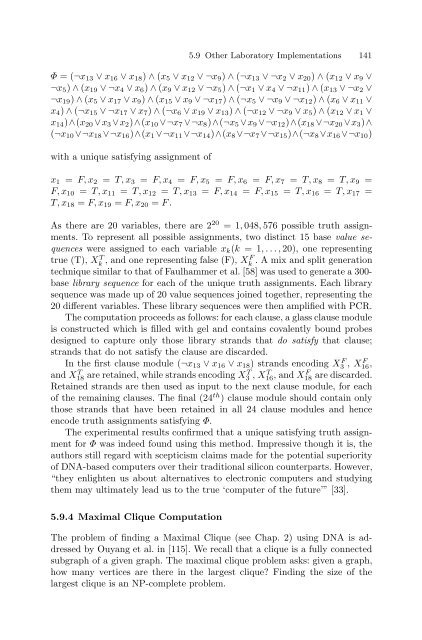Theoretical and Experimental DNA Computation (Natural ...
Theoretical and Experimental DNA Computation (Natural ...
Theoretical and Experimental DNA Computation (Natural ...
Create successful ePaper yourself
Turn your PDF publications into a flip-book with our unique Google optimized e-Paper software.
5.9 Other Laboratory Implementations 141<br />
Φ =(¬x13 ∨ x16 ∨ x18) ∧ (x5 ∨ x12 ∨¬x9) ∧ (¬x13 ∨¬x2 ∨ x20) ∧ (x12 ∨ x9 ∨<br />
¬x5) ∧ (x19 ∨¬x4 ∨ x6) ∧ (x9 ∨ x12 ∨¬x5) ∧ (¬x1 ∨ x4 ∨¬x11) ∧ (x13 ∨¬x2 ∨<br />
¬x19) ∧ (x5 ∨ x17 ∨ x9) ∧ (x15 ∨ x9 ∨¬x17) ∧ (¬x5 ∨¬x9 ∨¬x12) ∧ (x6 ∨ x11 ∨<br />
x4) ∧ (¬x15 ∨¬x17 ∨ x7) ∧ (¬x6 ∨ x19 ∨ x13) ∧ (¬x12 ∨¬x9 ∨ x5) ∧ (x12 ∨ x1 ∨<br />
x14)∧(x20 ∨x3 ∨x2)∧(x10 ∨¬x7 ∨¬x8)∧(¬x5 ∨x9 ∨¬x12)∧(x18 ∨¬x20 ∨x3)∧<br />
(¬x10 ∨¬x18 ∨¬x16)∧(x1 ∨¬x11 ∨¬x14)∧(x8 ∨¬x7 ∨¬x15)∧(¬x8∨x16 ∨¬x10)<br />
with a unique satisfying assignment of<br />
x1 = F, x2 = T,x3 = F, x4 = F, x5 = F, x6 = F, x7 = T,x8 = T,x9 =<br />
F, x10 = T,x11 = T,x12 = T,x13 = F, x14 = F, x15 = T,x16 = T,x17 =<br />
T,x18 = F, x19 = F, x20 = F .<br />
As there are 20 variables, there are 220 =1, 048, 576 possible truth assignments.<br />
To represent all possible assignments, two distinct 15 base value sequences<br />
were assigned to each variable xk(k =1,...,20), one representing<br />
true (T), X T k , <strong>and</strong> one representing false (F), XF k<br />
. A mix <strong>and</strong> split generation<br />
technique similar to that of Faulhammer et al. [58] was used to generate a 300base<br />
library sequence for each of the unique truth assignments. Each library<br />
sequence was made up of 20 value sequences joined together, representing the<br />
20 different variables. These library sequences were then amplified with PCR.<br />
The computation proceeds as follows: for each clause, a glass clause module<br />
is constructed which is filled with gel <strong>and</strong> contains covalently bound probes<br />
designed to capture only those library str<strong>and</strong>s that do satisfy that clause;<br />
str<strong>and</strong>s that do not satisfy the clause are discarded.<br />
In the first clause module (¬x13 ∨ x16 ∨ x18) str<strong>and</strong>s encoding X F 3 , XF 16 ,<br />
<strong>and</strong> X T 18 are retained, while str<strong>and</strong>s encoding X T 3 , X T 16, <strong>and</strong>X F 18 are discarded.<br />
Retained str<strong>and</strong>s are then used as input to the next clause module, for each<br />
of the remaining clauses. The final (24 th ) clause module should contain only<br />
those str<strong>and</strong>s that have been retained in all 24 clause modules <strong>and</strong> hence<br />
encode truth assignments satisfying Φ.<br />
The experimental results confirmed that a unique satisfying truth assignment<br />
for Φ was indeed found using this method. Impressive though it is, the<br />
authors still regard with scepticism claims made for the potential superiority<br />
of <strong>DNA</strong>-based computers over their traditional silicon counterparts. However,<br />
“they enlighten us about alternatives to electronic computers <strong>and</strong> studying<br />
them may ultimately lead us to the true ‘computer of the future’” [33].<br />
5.9.4 Maximal Clique <strong>Computation</strong><br />
The problem of finding a Maximal Clique (see Chap. 2) using <strong>DNA</strong> is addressed<br />
by Ouyang et al. in [115]. We recall that a clique is a fully connected<br />
subgraph of a given graph. The maximal clique problem asks: given a graph,<br />
how many vertices are there in the largest clique? Finding the size of the<br />
largest clique is an NP-complete problem.







